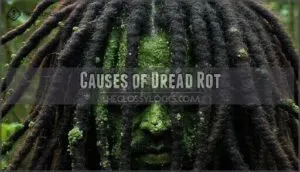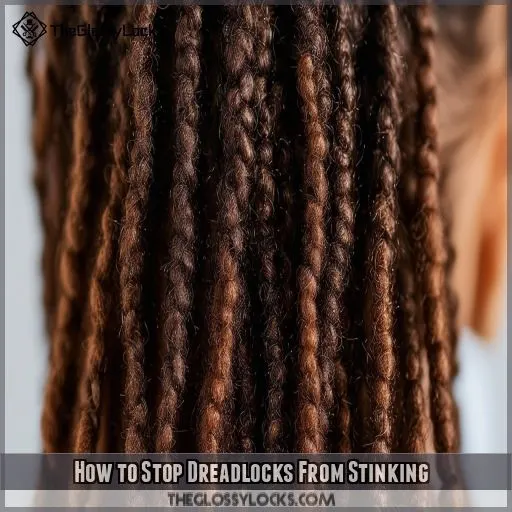This site is supported by our readers. We may earn a commission, at no cost to you, if you purchase through links.
1
But what happens when a silent invader, known as dread rot, strikes?
Moldy dreadlocks can undermine the strength and beauty of your locs if left untreated.
Understanding the causes, prevention methods, and treatments of dread rot is essential for maintaining healthy and vibrant locs.
This article will provide you with seven expert tips to fortify your dreadlocks against mold, ensuring their health and vitality.
Follow our precise and research-based advice to become a master of dreadlock care and efficiently prevent dread rot.
Table Of Contents
- Key Takeaways
- What is Dread Rot?
- Causes of Dread Rot
- Does Mold Grow in Dreadlocks?
- The White Stuff in Dreads
- How to Stop Dreadlocks From Stinking
- Why You Should Dry Your Dreadlocks Fully and Quickly
- How to Dry Your Dreadlocks After Washing Them
- Dread Rot Prevention and Treatment
- Frequently Asked Questions (FAQs)
- What is dread rot?
- What causes LOC rot?
- Does mold grow in dreadlocks?
- What is the white stuff in dreads?
- How long does it take for dread rot to occur?
- Can dread rot be caused by environmental factors?
- Can dread rot be prevented with regular washing?
- What are the long-term effects of dread rot?
- Are there any home remedies for treating dread rot?
- Conclusion
Key Takeaways
Dreadlocks are a fortress, but a silent enemy lurks: dread rot, caused by mold and bacteria. Keep those dreads dry! excess moisture creates a breeding ground for mold. Regular deep cleaning with baking soda or vinegar soaks will prevent and treat dread rot. Early detection and proper care are crucial to maintaining healthy, vibrant dreadlocks.
What is Dread Rot?
You’ve probably heard whispers about dread rot, but what exactly is this dreaded dreadlock dilemma? It’s a tough problem that can leave your locks smelling funky and feeling less than fresh. Dread rot occurs when fungal growth and microbial contamination take hold within your dreadlocks, leading to hair damage and potential scalp irritation.
This insidious issue can sneak up on even the most vigilant dreadhead, causing dreadlock deterioration from the inside out. You might notice an unpleasant smell, reminiscent of mildew or wet dog, emanating from your locks. As the problem progresses, you could spot discoloration or fuzzy patches on your dreads.
Don’t panic! While dread rot is a serious concern, it’s not a death sentence for your locks. With the right approach, including using a deep cleansing shampoo and proper maintenance, you can tackle this fungal foe head-on.
Causes of Dread Rot
Dread rot is primarily caused by improper dreadlock care, excessive moisture retention, and residue buildup issues. You’re at risk if you don’t properly maintain your dreads, allow them to stay wet for long periods, or use products that leave behind residue in your locks.
Improper Dreadlock Care
Improper dreadlock care can quickly lead to dread rot. You’re not off the hook after locking your hair. To keep your dreads healthy and rot-free, avoid these common mistakes:
- Using wax or heavy products that cause residue buildup
- Washing too frequently or with improper shampoos
- Neglecting deep cleansing sessions
- Failing to dry locks thoroughly after washing
- Ignoring early signs of moisture retention or odor
Master your dread care routine to keep your locks fresh and powerful, like a grymkin pathfinder leading the dark menagerie.
Excessive Moisture Retention
Excessive moisture retention is a key culprit in dread rot. You’re in effect creating a perfect breeding ground for mold when you don’t dry your locks properly. Here’s a breakdown of common moisture-related issues:
| Issue | Consequence |
|---|---|
| Poor drying | Trapped moisture |
| Excessive washing | Oversaturation |
| Improper shampooing | Residue buildup |
| Improper drying | Prolonged dampness |
| Humid environments | Slow evaporation |
Like a corpse token in "Bump in the Night," moisture lingers, turning your dreadlocks into a weapon master of mold growth.
Residue Buildup Issues
Residue buildup in your dreadlocks can be a major culprit behind dread rot. Poor dreadlock hygiene and improper product use lead to this issue. Here’s what you need to watch out for:
- Wax buildup from overuse
- Excessive washing with harsh shampoos
- Improper shampoo selection leaving residue
- Moisture management failures
These factors trap moisture and create a breeding ground for mold. Combat this with regular vinegar soaks, baking soda treatments, and careful scalp care, even for dreadlock extensions.
Does Mold Grow in Dreadlocks?
Now that you understand the causes of dread rot, let’s tackle a significant question: Can mold actually grow in your dreadlocks? The answer might surprise you. Yes, mold can indeed thrive in your locs if conditions are right.
Think of your dreads as a miniature ecosystem – when moisture gets trapped, it’s like rolling out the red carpet for unwanted guests. Mold risks skyrocket in humid environments, making odor control and moisture management essential for maintaining hygienic dreadlocks.
Imagine your locs as a battlefield – you’re the commander, and mold is the invading army. Your weapons? Proper drying techniques and regular maintenance. Don’t let your dreads become a victim of neglect.
The White Stuff in Dreads
You might notice white stuff in your dreads, and it’s not always a cause for alarm. However, it’s important to identify what you’re dealing with.
Dandruff buildup is common, often resembling a farming implement’s residue. Bacterial infections can also cause white patches, potentially leading to scalp irritation and hair follicle damage. In severe cases, you might experience hair loss, turning your locks into victuals you can neither raise nor buy.
Don’t panic, though! This white stuff could be your scalp’s natural oils or product residue. To combat it, consider a deep cleaning approach: use a clarifying shampoo to penetrate deep into your dreads.
If the issue persists, consult a trichologist for an effective treatment strategy against dread rot. Remember, early detection and proper care are key to maintaining healthy, vibrant dreadlocks.
How to Stop Dreadlocks From Stinking
To combat dread rot and stop your dreadlocks from stinking, you’ll need to focus on deep cleansing and disinfecting techniques. Use a deep cleansing shampoo to remove buildup, then follow up with either a baking soda soak or vinegar rinse to neutralize odors and kill mold-causing bacteria.
Use a Deep Cleansing Shampoo
To keep your dreads fresh, choose a deep cleansing shampoo that will remove residue.
Look for products designed specifically for locs.
These shampoos will tackle buildup without leaving behind any unwanted residue.
Opt for clarifying shampoos with natural ingredients like tea tree oil or apple cider vinegar.
These powerhouse cleansers will leave your dreads squeaky clean and smelling great.
Soak Your Dreadlocks in Baking Soda
Baking soda is a powerful tool in your arsenal against dread rot. It’s time to deep clean those locks and give them some much-needed TLC. Here’s how:
- Mix a quarter cup of baking soda with a gallon of water.
- Stir the solution until the baking soda is completely dissolved.
- Submerge your dreadlocks in the solution for 10-15 minutes.
- Rinse and repeat as needed to make certain your locks are mold and residue-free.
Do a Vinegar Soak
If you’re dealing with a case of stinky dreadlocks, a vinegar soak is a powerful weapon in your arsenal. This method is a tried-and-true way to neutralize odors and restore your locks to their former glory.
The process is simple: mix a cup of apple cider vinegar with water, creating a powerful solution to banish unwanted odors. Submerge your dreads in this mixture for 10-15 minutes, and you’ll be well on your way to fresh-smelling hair. Rinse and repeat as needed to maintain a healthy scalp and locks.
Why You Should Dry Your Dreadlocks Fully and Quickly
Now that you know how to stop your dreadlocks from stinking, let’s talk about why it’s important to dry them fully and quickly.
Dreadlocks are prone to mold growth due to their intricate structure, which can trap moisture and create the perfect environment for mold to thrive. By ensuring that your dreadlocks are completely dry, you reduce the risk of mold and promote scalp health.
Airflow and ventilation are essential to the drying process. When drying your dreadlocks, it’s important to use a towel to absorb excess moisture and then allow them to air dry completely. Blow drying can be an option, but it’s important to use a low heat setting and keep the dryer moving to avoid overheating and damaging your hair.
How to Dry Your Dreadlocks After Washing Them
Now that you comprehend the significance of drying your dreadlocks rapidly and thoroughly, let’s explore the various techniques you can employ to achieve this. Here are some methods to examine:
- Towel Drying Tips: After washing your dreadlocks, utilize a clean, absorbent towel to cautiously squeeze out excess water. Refrain from twisting or wringing your dreadlocks as this can cause damage and frizz. Instead, pat and press the towel against your locks.
- Air Drying Benefits: Permitting your dreadlocks to air dry is a gentle and practical option. Simply make certain they’re exposed to good airflow, and if possible, sit under a fan to hasten the process.
- Sun Drying Advantages: Natural sunlight is a potent tool in your dreadlock drying arsenal. It not merely provides heat to accelerate drying, but the UV rays also possess a sanitizing effect, helping to keep your locks fresh and clean.
- Blow Dry Techniques: If you prefer a quicker drying method, a blow dryer can be used on a low heat setting. Hold the dryer at least 6 inches away from your dreadlocks and continuously move it to avoid concentrating the heat in one area for too long.
- Diffuser Drying Options: When using a blow dryer, consider attaching a diffuser. This attachment distributes the airflow more evenly, reducing the risk of heat damage and helping to maintain the shape of your dreadlocks.
Dread Rot Prevention and Treatment
Now that you understand how to dry your dreadlocks effectively, let’s examine the specifics of preventing and treating dread rot. Maintaining effective dreadlock hygiene is essential for keeping your locks healthy and mold-free.
To prevent dread rot, focus on two key areas: proper drying and residue removal. As mentioned earlier, make certain your dreadlocks are thoroughly dry after washing, using sunlight or a blow dryer if necessary. This simple step goes a long way in preventing mold growth.
Additionally, regularly remove residue buildup from your dreadlocks. Residue creates an inviting environment for mold, so it’s important to keep your locks clean. Deep cleansing shampoos and baking soda soaks are effective tools for this purpose.
If you notice any signs of dread rot, such as an unusual odor or discoloration, take action immediately. Treat dread rot by cutting or combing out the affected locks. You can also try a vinegar soak to kill mold and refresh your dreads. Mix a cup of apple cider vinegar with 15-20 drops of tea tree oil and optionally, 20-30 drops of grapefruit seed extract. Submerge your dreadlocks in this solution for 10-15 minutes, then rinse and dry thoroughly.
Frequently Asked Questions (FAQs)
What is dread rot?
Dread rot is caused by damp dreadlocks, leading to mold growth and an unpleasant smell. Symptoms include a mildew, mold, or wet dog odor, and discoloration.
What causes LOC rot?
LOC rot is caused by excess moisture that isn’t dried properly. This creates a breeding ground for mold and fungus. To prevent LOC rot, make sure your hair is completely dry after washing.
Does mold grow in dreadlocks?
Yes, mould can grow in dreadlocks if they are not dried properly after washing.
This creates a damp environment, providing the humidity mould needs to thrive—similar to how it grows on a wet shower curtain or towel.
While mould cannot grow on hair alone due to a lack of nutrients, it may access these nutrients if hair is constantly humid or chemically damaged.
What is the white stuff in dreads?
The white stuff in your dreads could be caused by excess sebum, dandruff, product buildup, club hairs, bugs (lice nits), mold, or lint.
How long does it take for dread rot to occur?
It’s not clear how long it takes for dread rot to occur. However, it’s caused by washing your dreadlocks too often and not drying them thoroughly. Make sure your dreadlocks are completely dry, and rinse your hair thoroughly to avoid buildup.
Can dread rot be caused by environmental factors?
Yes, environmental factors like humidity and rain can increase the risk of dread rot. The condition is caused by mold growth due to improper drying, excessive moisture, and non-organic product use.
Can dread rot be prevented with regular washing?
Regular washing is vital, but it’s equally critical to make certain your dreadlocks are thoroughly dried afterward. Proper drying techniques and shampoos that leave no residue are key to preventing dread rot.
What are the long-term effects of dread rot?
If left untreated, dread rot can cause serious damage to hair follicles, leading to follicle decay, baldness, or bald patches. It can also obstruct proper blood flow and leave an unpleasant, lingering odor.
Are there any home remedies for treating dread rot?
A stitch in time saves nine."
If you’re dealing with dread rot, there are a few home remedies you can try. First, use a vinegar rinse cleanser to remove mold and odour. Next, wash with a natural, residue-free shampoo to prevent buildup and speed up drying time. Finally, make certain your dreadlocks are thoroughly dried to prevent mold and mildew growth.
Conclusion
An ounce of prevention is worth a pound of cure." This saying certainly applies when it comes to the dreaded dread rot.
By following these seven expert tips, you can protect your dreadlocks from mold and keep them healthy and vibrant.
Proper dreadlock care, quick drying, and regular deep cleansing are key to preventing and treating this issue.
Keep reading to discover the exact steps you need to take to safeguard your locs and maintain their strength and beauty. Stay vigilant, and keep that insidious invader at bay!











